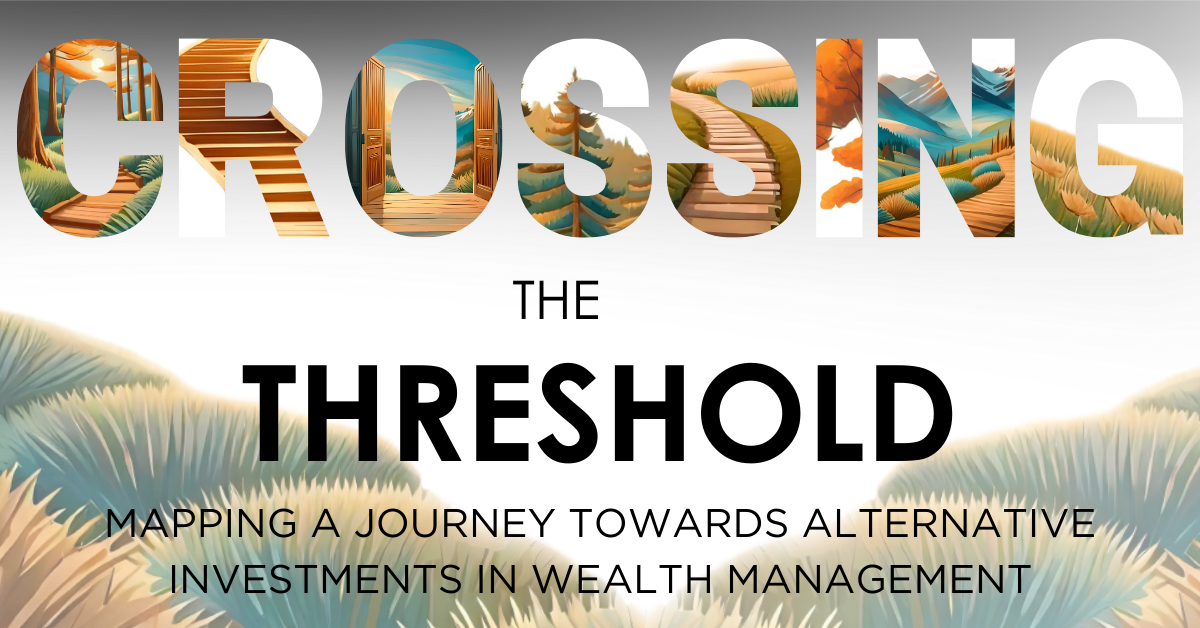By Aaron Filbeck, CAIA, CFA, CFP®, CIPM, FDP, Managing Director, Head of UniFi by CAIA™.
I recently had the opportunity to sit down with Sandy Kaul, SVP at Franklin Templeton and a key contributor to CAIA Association’s recent 'Crossing the Threshold' report. During our conversation, Sandy provided an overview of the history of democratizing access to alternative investments and offered us a compelling vision of the future. Watch the video above and read on for some key takeaways!
Laying the Groundwork
Every good adventure story begins with an important exercise: “world-building”. At this stage, we are introduced to the physical setting, historical context, cultural norms, and perhaps some of the key players who will later hold significance within the story. By laying out key facts and parameters, world-building presents the reality and history that may help provide the context we need to understand why things are the way they are.
In the faraway land of democratization, our industry has been building a world of its own. As many of us know, the pathways to making alternative investments more widely available to investors outside the institutional investment communities and/or ultra-wealthy individuals have increased. History can teach us a lot, and it’s important to understand the shifts that have already happened, the lessons learned, and how the industry will likely look moving forward.
In my conversation with Sandy, we focused on a few of the standout topics from her contribution to the report. I’d encourage you to read it all, but I’ll highlight one that I believe will continue to be at the forefront—the accelerated trend of the “buy-or-build” model found across the asset management industry.
Figure 1: Alternative Investments Contribute More than Half of Industry Revenues

Source: Boston Consulting Group Asset Management Report 2024
Buy or Build
In my view, the growth in alternative investments is driven by a combination of supply (asset management firms), demand (investors), and technology (marketplace, vehicles, and intermediary providers). There are many reasons underlying each of these factors but, in my opinion, Figure 1 perfectly summarizes one of the largest drivers on the “supply” side: the business and revenue case. No matter how you measure it, alternative investment funds now represent over half of the industry’s revenues, despite only representing a quarter of industry AUM. The further accelerant being diversifying client-bases and moving into private wealth.
The rush to not only offer alternatives, but to also pursue private wealth at the same time, has prompted firms to follow one of two primary paths (with perhaps a messy middle)—buy or build.
- The “buyer” strategy is typically pursued by firms seeking a more robust product lineup and/or those without wealth management-focused distribution capabilities. To date, most “buyers” have long-only asset management firms that may have deep wealth management networks but little to no product.
- The “builder” strategy is typically pursued by firms that have in-house expertise or perhaps the beginnings of what could be strong product lineups that simply need renewed focus and distribution. To date, most “builders” are institutionally focused GPs that have sophisticated product expertise but little to no wealth management distribution capabilities.
If you find this interesting, you’ll love our full conversation or read the entire report here!
About the Author:
Aaron Filbeck, CAIA, CFA, CFP®, CIPM, FDP oversees UniFi by CAIA™, a learning platform dedicated to educating the private wealth management industry on alternative investments. He was previously responsible for leading and implementing CAIA Association's content agenda, thought leadership initiatives, and content development for the CAIA Charter Program.

Aaron is a frequent speaker and writer on various topics of alternative investments and his work has been published in CAIA’s educational programs, numerous academic journals, books, and industry publications. Aaron’s industry experience lies in private wealth management, where he oversaw asset allocation, portfolio construction, and manager research efforts for high-net-worth individuals and institutional retirement plans.
He earned a B.S. with distinction in Finance and a Master of Finance from Penn State University. He holds the Chartered Alternative Investment Analyst (CAIA), Chartered Financial Analyst (CFA), Certificate in Investment Performance Measurement (CIPM), and Financial Data Professional (FDP) designations, and is a CERTIFIED FINANCIAL PLANNER™. He is a Past President of CFA Society Columbus and serves as a board director and Programs Chair for CFA Society Philadelphia. Aaron is an adjunct professor and serves on multiple advisory boards for Penn State University.




